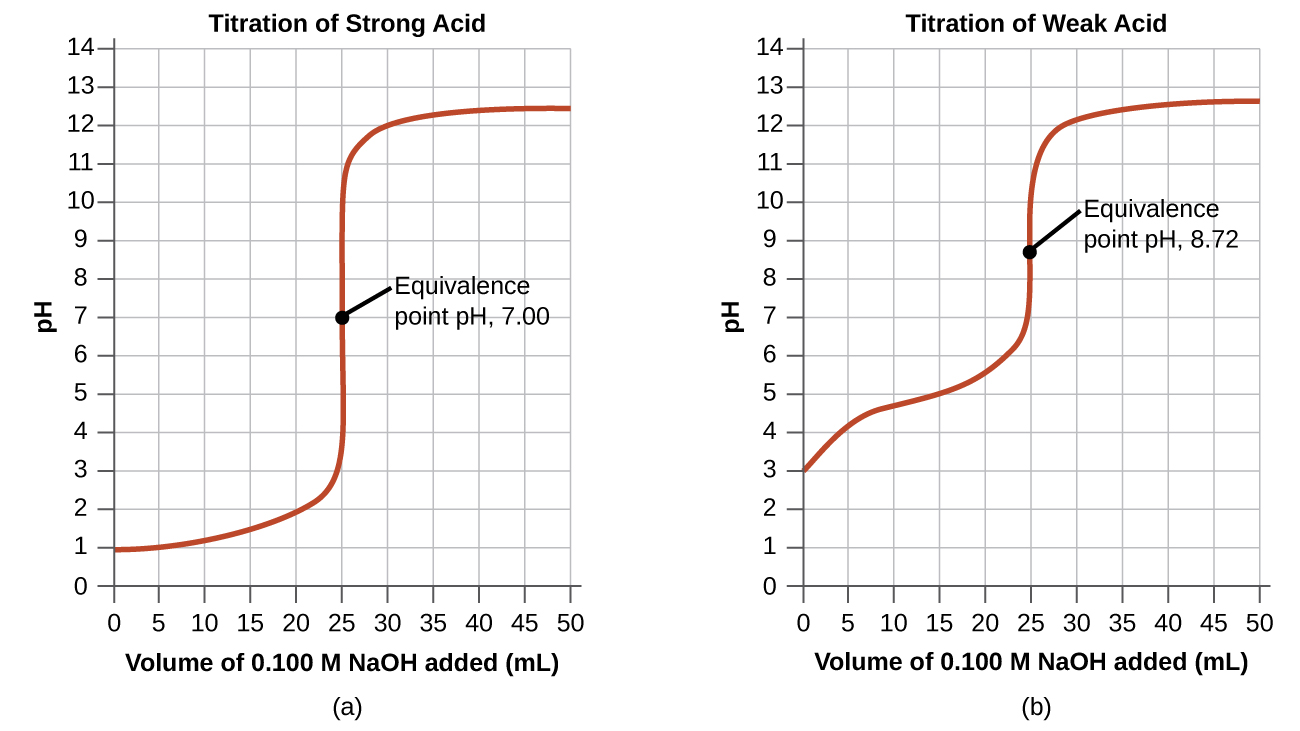A #"25.0-mL"# sample of #"0.150-mol L"^(-1)# acetic acid is titrated with a #"0.150-mol L"^(-1)# #"NaOH"# solution. What is the #"pH"# at the equivalence point?
The #K_a# of acetic acid is #1.8 xx 10^(-5)# .
a)8.81
b)10.38
c)9.26
d)5.19
e)7.00
(show steps please!! thanks!!)
The answer is 8.81 but I am not sure how to get it
The
a)8.81
b)10.38
c)9.26
d)5.19
e)7.00
(show steps please!! thanks!!)
The answer is 8.81 but I am not sure how to get it
1 Answer
Explanation:
!! LONG ANSWER !!
The trick here is to realize that in order to reach the equivalence point, you need to add enough moles of sodium hydroxide, which I'll represent as hydroxide anions because this compound is a strong base, to consume all the moles of acetic acid present in the initial solution.
For a weak acid - strong base titration, you have
#color(blue)(ul(color(black)("equivalence point "))) = {("all the moles of the weak acid are consumed"), ("all the moles of the strong base added are consumed") :}#
As you know, acetic acid and sodium hydroxide neutralize each other in a
#"CH"_ 3"COOH"_ ((aq)) + "OH"_ ((aq))^(-) -> "CH"_ 3"COO"_ ((aq))^(-) + "H"_ 2"O"_ ((l))#
Now, use the molarity and the volume of the acetic acid solution to determine how many moles of acetic acid are present in the initial solution.
#25.0 color(red)(cancel(color(black)("mL solution"))) * ("0.150 moles CH"_ 3"COOH")/(10^3color(red)(cancel(color(black)("mL solution")))) = "0.00375 moles CH"_3"COOH"#
This means that in order to reach the equivalence point, you need to add
Since the sodium hydroxide solution has the same molarity as the acetic acid solution, it follows that you will need to add
This means that after you mix the two solutions, the total volume of the resulting solution will be
#"25.0 mL + 25.0 mL = 50.0 mL"#
Now, notice that for every mole of acetic acid and of hydroxide anions that the reaction consumes, you get
Since the reaction consumes
The concentration of the acetate anions in the resulting solution will be--do not forget to convert the volume of the solution to liters!
#["CH"_ 3"COO"^(-)] = "0.00375 moles"/(50.0 * 10^(-3) quad "L") = "0.0750 mol L"^(-1)#
Now, the acetate anions will act as a weak base in aqueous solution. These anions will react with water to reform some of the weak acid and produce hydroxide anions.
#"CH"_ 3"COO"_ ((aq))^(-) + "H"_ 2"O"_ ((l)) rightleftharpoons "CH"_ 3"COOH"_ ((aq)) + "OH"_ ((aq))^(-)#
At this point, it should become clear that the
As you know, an aqueous solution at
#color(blue)(ul(color(black)(K_a * K_b = 1.0 * 10^(-14))))#
Here
#K_a# is the acid dissociation constant of the weak acid#K_b# is the base dissociation constant of the conjugate base
In your case, you have
#K_b = (1.0 * 10^(-14))/(1.8 * 10^(-5)) = 5.556 * 10^(-10)#
By definition, the base dissociation constant for the ionization of the acetate anions is equal to
#K_b = (["CH"_ 3"COOH"] * ["OH"^(-)])/(["CH"_3"COO"^(-)])#
If you start with
#["CH"_ 3"COOH" ] = ["OH"^(-)] = x quad "mol L"^(-1)# For every mole of acetate anions that reacts with water, you get
#1# mole of acetic acid and#1# mole of hydroxide anions.
#["CH"_3"COO"^(-)] = (0.075 - x) quad "mol L"^(-1)# For every mole of acetate anions that reacts with water, the number of moles of acetate anions decreases by
#1# mole.
Plug this into the expression of the base dissociation constant to get
#K_b = (x * x)/(0.075 - x)#
#K_b = x^2/(0.075 - x)#
Now, because the value of base dissociation constant is significantly smaller than the initial concentration of the acetate anions, you can use the approximation
#0.075 - x ~~ 0.075#
This means that you have
#K_b = x^2/0.075#
which gets you
#x = sqrt(0.075 * 5.556 * 10^(-10)) = 6.455 * 10^(-6)#
Since
#["OH"^(-)] = 6.455 8 10^(-6) quad "mol L"^(-1)#
Finally, you know that an aqueous solution at
#color(blue)(ul(color(black)("pH + pOH = 14")))#
Since
#color(blue)(ul(color(black)("pOH" = - log(["OH"^(-)]))))#
you can say that the
#"pH" = 14 + log(["OH"^(-)])#
Plug in your value to find
#"pH" = 14 + log(6.455 * 10^(-6)) = color(darkgreen)(ul(color(black)(8.81)))#
I'll leave the answer rounded to two decimal places, but keep in mind that you have three sig figs for your values, so you should report the answer as
#"pH" = 8.810#
Notice that the


